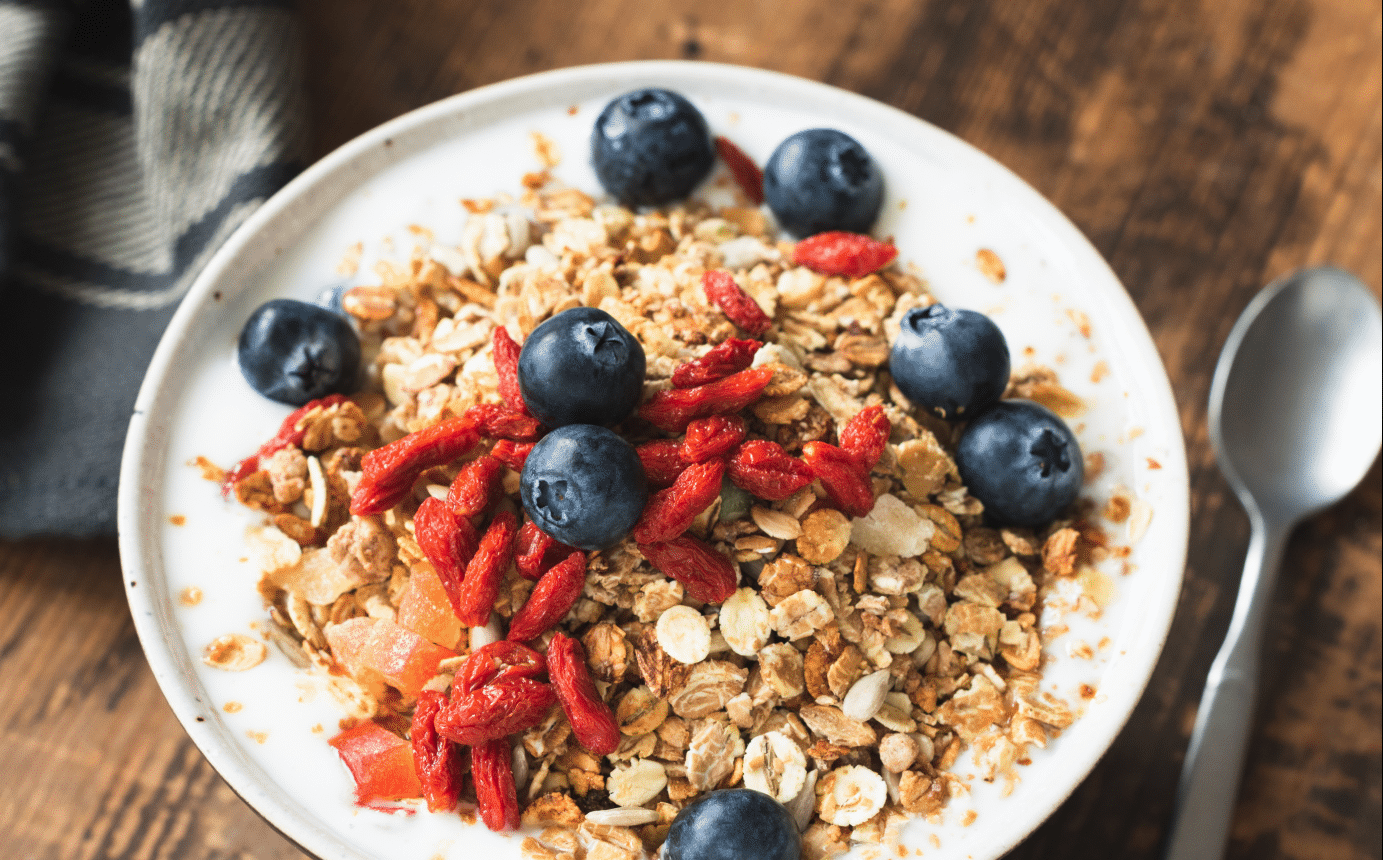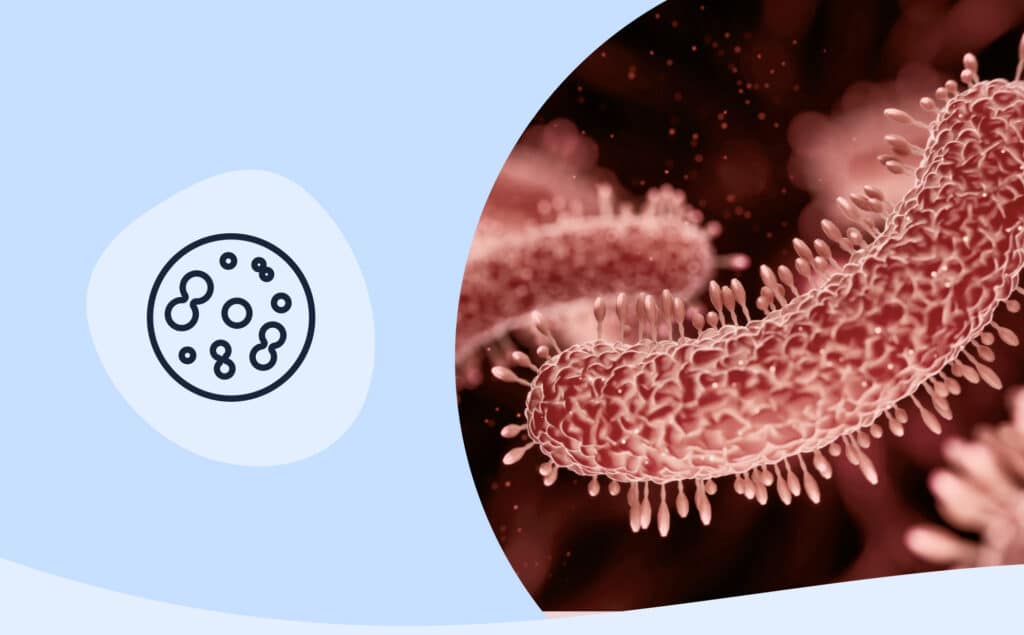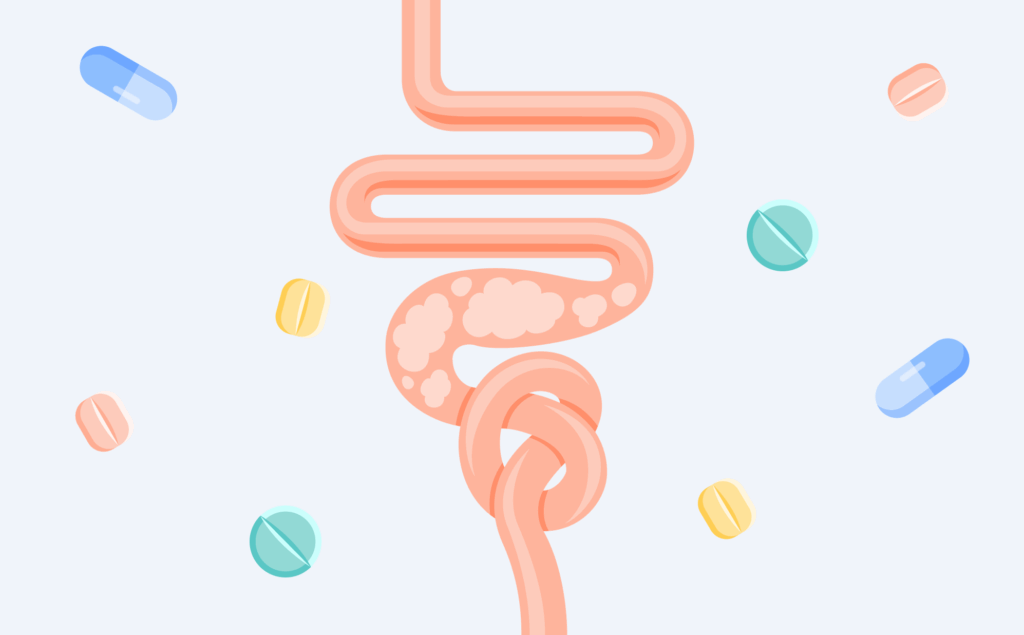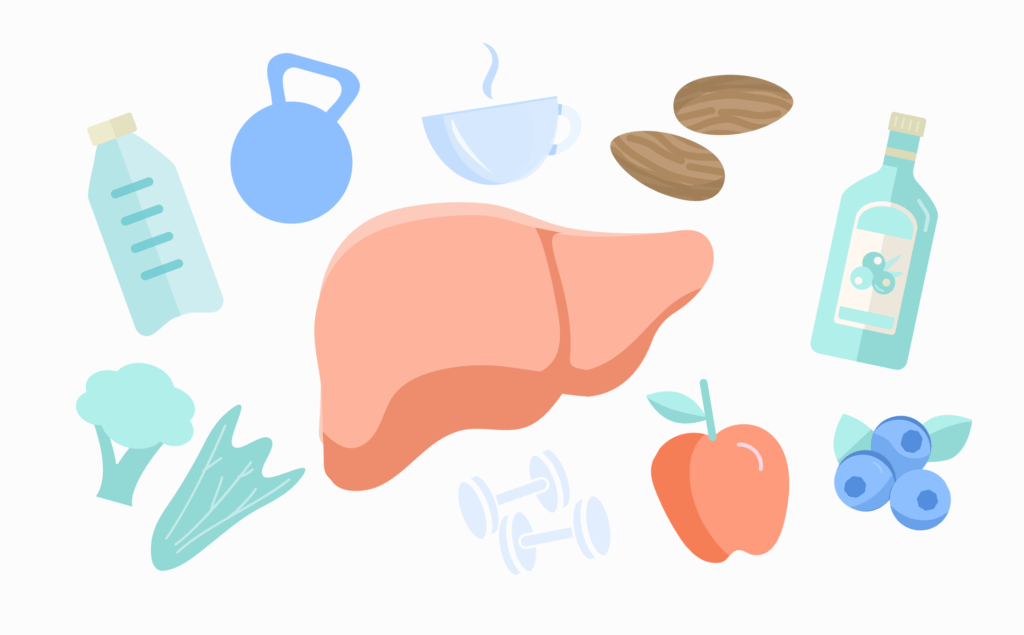Constipation leads to uncomfortable symptoms like abdominal pain, bloating, and difficulty passing stool. While there are many habits that may help get things moving, eating fiber stands out as an effective and easy-to-try option. Here’s the ultimate high-fiber foods chart for constipation, plus tips to make sure your fiber intake isn’t too high or too low.
Many of us have experienced the feeling of needing to poop but not being able to at one point or another. This feeling is called constipation, something 16% of adults experience frequently. When constipation hits, it’s normal to feel desperate to get those bowels moving: jumping up and down, massaging the stomach, drinking prune juice, etc..
One tip that involves less jumping, though possibly still the prunes? Eating more fiber. Fiber is a substance found in plant foods that the body cannot digest easily. As it passes through the digestive tract, it acts like a broom, cleaning out any build-up. But to be honest, the advice to”eat more fiber” without a list of foods and recipes to try isn’t very helpful. That’s why we’ve compiled this high-fiber foods chart for constipation that’s so thorough, it should include at least one source of fiber that you’ll actually enjoy.
Fiber 101
I consider it a victory if I clean my apartment once a week. Fiber, on the other hand, is working to clean up the digestive system daily. But what exactly is this nutritional substance?
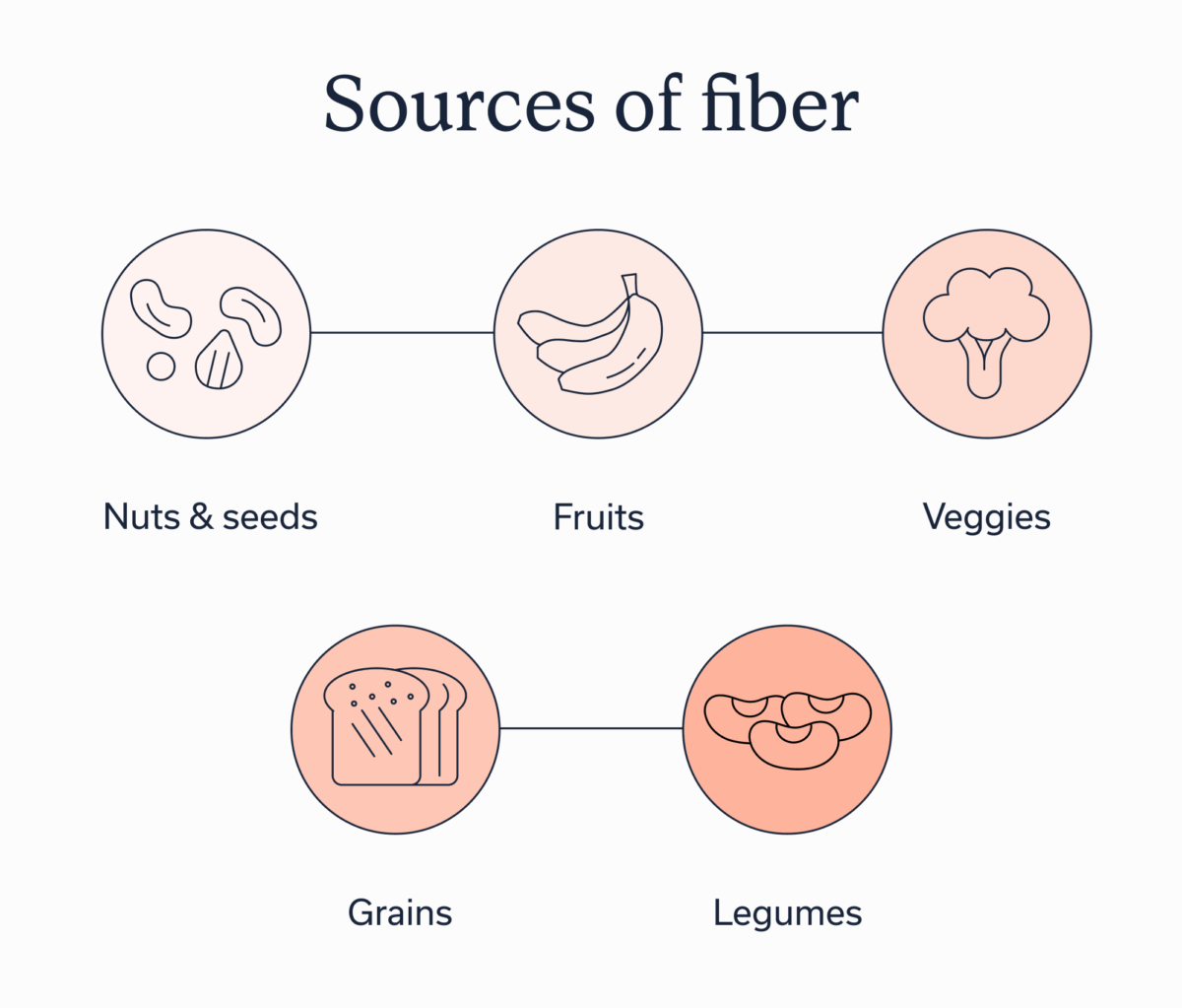
“Fiber is a term we use to describe the non-digestible parts of plant foods, such as fruits, vegetables, grains, nuts, seeds, beans, etc.,” says Kaitlin Voicechovski, MS, RDN, LDN, Lead Registered Dietitian at Oshi Health, “Fiber is known to offer a host of benefits, and most people don’t get enough of it in their diet.” In fact, Americans only eat an average of 16 grams of fiber per day when the recommended amount is 21-38 grams.
That means most of us are missing out on all the incredible ways fiber supports our health. A fiber-rich diet can help us:
- Feel full for longer: Perhaps it’s best known effect, fiber helps you feel full longer since it’s not easy to digest, meaning it moves through the digestive tract slower.
- Control blood sugar: Most carbohydrates are broken down and absorbed into the bloodstream, affecting blood sugar. Since the body can’t absorb and break down fiber like other carbohydrates, it doesn’t enter the bloodstream in the first place. It can also bind to some fats and cholesterol, which do increase blood sugar, and stop them from entering.
- Protect heart health: When there are more fats and cholesterol in the bloodstream, there’s a higher risk of heart disease. Thanks to fiber’s ability to bind to some of these, it can be considered a heart-friendly nutrient.
- Reduce risk for certain medical conditions: Along with lowering the risk of heart disease and helping with blood sugar, getting enough fiber is also linked to a lower chance of irritable bowel syndrome, obesity, and colon cancer.
- Keep the digestive system regular: And of course, the reason we’re all here, fiber cleans out the digestive tract and keeps things moving. This reduces the risk of constipation and can help if someone is already constipated.
And when it comes to keeping things moving, it’s important to get both types of fiber: soluble and insoluble. “Soluble fiber, as its name suggests, is soluble in water, while insoluble fiber is not,” explains Voicechovski, “A fiber’s solubility impacts how it behaves in the GI tract, and each of their unique properties can be leveraged to support different GI symptoms.”
Insoluble fiber is rougher and can’t be broken down by water, meaning it basically leaves the body the same as it went in. While in the digestive system, insoluble fiber adds quite a bit of bulk to stool. Heavier stool can stimulate intestine muscles to contract and instigate a bowel movement, relieving constipation. Skins and seeds from fruit and veggies, popcorn, and nuts are good examples of insoluble fibers.
Before you opt for only insoluble fiber, remember that soluble fiber helps with constipation too. Since this type is broken down by water, it can soften hard stool, making it easier to poop. Soluble fiber sources include cooked vegetables, bananas, whole grains, and oatmeal.
For those who are experiencing GI distress, such as an irritable bowel syndrome (IBS) flare-up, soluble fiber is often easier to digest. And you may want to give insoluble fiber the cold shoulder until the flare dies down.
The high-fiber foods chart
Now that we’ve established why the hype around fiber is warranted, where exactly can you find it? The chart below contains some of the foods with the highest concentration of fiber, plus what type they contain.
| Food | Serving size | Total fiber | Fiber type |
| Almonds | 1 ounce | 2-3.5 grams | Insoluble |
| Apples (with skin) | 1 medium apple | 3.5 grams | Contains both |
| Avocado | ¼ of an avocado | 2.5 grams | Contains both |
| Black beans | ½ a cup | 5 grams | Contains both |
| Blackberries | ½ a cup | 4 grams | Contains both |
| Bran cereals | ½ a cup | 4-9 grams (varies by brand) | Insoluble fiber |
| Broccoli | ½ a cup | 2.5 grams | Contains both |
| Brown rice | ½ a cup | 2 grams | Insoluble fiber |
| Brussels sprouts | ½ a cup | 2 grams | Contains both |
| Bulgur | ½ a cup | 4 grams | Insoluble fiber |
| Carrots | ½ a cup | 2 grams | Contains both |
| Chia seeds | 1 Tbsp | 5 grams | Contains both |
| Chickpeas | ½ a cup | 5 grams | Contains both |
| Green peas | ½ a cup | 4 grams | Contains both |
| Ground flaxseed | 1 Tbsp | 2 grams | Contains both |
| Kidney beans | ½ a cup | 7 grams | Contains both |
| Kiwi | 1 kiwi | 2 grams | Contains both |
| Lima beans | ½ a cup | 7 grams | Contains both |
| Lentils | ½ a cup | 8 grams | Contains both |
| Oats | Almonds | Almonds | Contains both |
| Oranges | ½ a cup | 2-4 grams (varies by brand) | Contains both |
| Pears (with skin) | ½ a cup | 2 grams | Contains both |
| Pistachios | 1 ounce | 2-3.5 grams | Insoluble |
| Prunes | 5 prunes | 3-5 grams | Contains both |
| Psyllium | 1 Tbsp. | 3 grams | Contains both |
| Pumpkin | ½ a cup | 3.5 grams | Contains both |
| Quinoa | ½ a cup | 5 grams | Insoluble |
| Raspberries | ½ a cup | 4 grams | Contains both |
| Spinach | ½ a cup | 2.5-3.5 grams | Insoluble |
| Split peas | ½ a cup | 8 grams | Contains both |
| Sweet potato (with skin) | 1 medium potato | 5 grams | Contains both |
| Turnips | 1 medium | 2 grams | Contains both |
| Whole-wheat pasta | ½ a cup | 3 grams | Insoluble |
Best fiber for constipation: What evidence supports
Most of the foods in the chart above will help with constipation, and it’s not a competition to find the”best fiber for constipation.” But if it were, the following would be serious contenders:
- Apples: If, like me, you’re not a fan of prunes, apples and apple juice also contain fiber and sorbitol, a sugar alcohol which doesn’t break down in the digestive tract and may help facilitate regular bowel movements. The concentration of sorbitol is lower in apples than it is in prunes, though.
- Kiwis: “ The RDs here at Oshi love to talk about kiwis for constipation,” says Voicechovski, “Not only are they packed with fiber, but they contain an enzyme known as actinidin believed to offer additional laxation benefits.”
- Psyllium: If you did a double take when you saw this one in the chart, you’re not alone; I had to look up what it was too. Psyllium is a natural laxative derived from the Plantago ovata plant that can be purchased as a powder, capsule, liquid, or wafer. While effective at getting things moving, it’s generally not recommended to take it for more than a week since it’s quite good at its job.
- Prunes: Of course, yes, the rumors are true–drinking prune juice or eating prunes will help with constipation.
Quick-start high-fiber day
Recipes and pre-planned meals are my love language. If you also prefer to have plenty of meal ideas on hand, here’s a menu for a high-fiber day of eats:
| Meal | Recipe | Reasoning |
| Breakfast | Apple cinnamon overnight oats | Apple and oats both contain fiber. Plus, the fact that you make these the night before makes it easier to choose a healthy breakfast, even if you press snooze. |
| Lunch | Chickpea chopped salad | In general, any meals with beans or legumes, including chickpeas, are a high-fiber option. This salad also contains veggies which are also high in fiber. |
| Snack | Chia seed pudding | Voicechovski often recommends chia pudding because it’s a high-fiber, flavorful snack. |
| Dinner | Herbed salmon with sweet potatoes and green beans | Green beans and sweet potatoes both contain fiber. While salmon does not, it will not make constipation worse, and it is a good source of protein. |
How to add fiber without the bloat
Too much of a good thing can be a bad thing, especially if you go from zero to one hundred quickly. In this case, too much fiber takes the shape of bloating, flatulence (passing gas), and even bowel obstruction, a blockage that prevents stool from passing through the intestines, in rare but severe cases.
To avoid this, take it slow with fiber. “Fiber is your friend, but if you’re falling short of it, it’s best to increase slowly over time rather than making dramatic jumps,” explains Voicechovski, “This makes it easier for the body to adjust and can make your transition to a higher fiber diet smoother.”
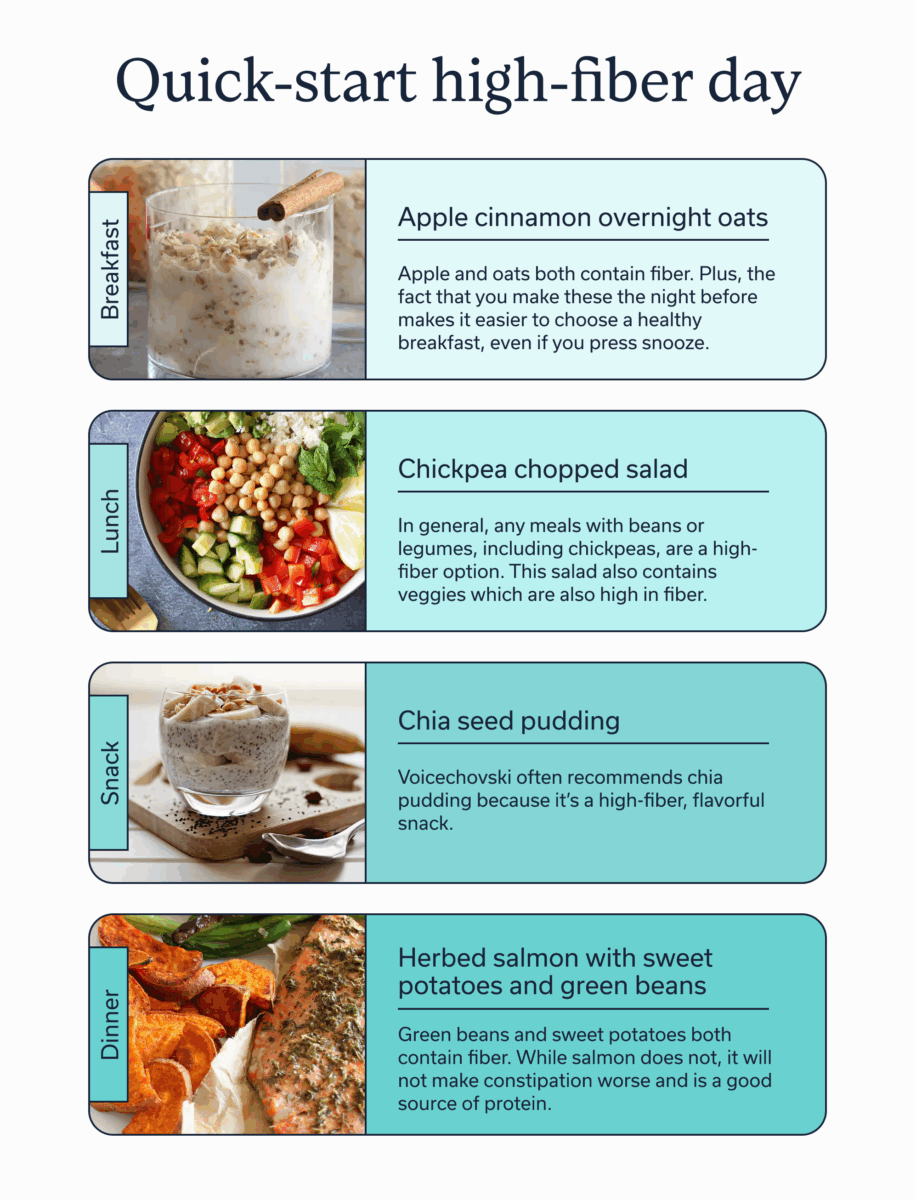
Fiber also pairs nicely with hydration. “Hydration matters! Increasing fiber intake alone without adequate fluid is unlikely to resolve constipation, and may actually exacerbate unwanted GI symptoms like gas and bloating,” says Voicechovski, “Make sure that you are appropriately hydrated, especially if considering an increase in fiber.”
Finally, those with gastrointestinal conditions like IBS and inflammatory bowel disease (IBD) may respond differently to fiber, making it important to work with a GI registered dietitian to determine how much to consume and what types of fiber you can tolerate.
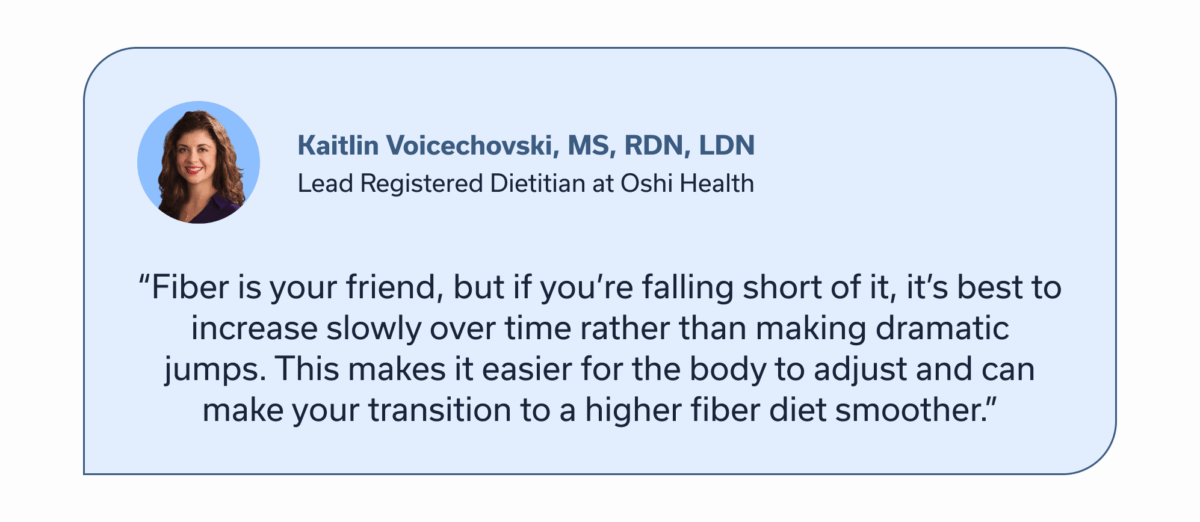
Fiber supplements: Choosing & using them safely
If you struggle to get enough fiber from diet alone, a supplement may help. Psyllium, which we discussed above, falls into the supplement category. It’s not the only fiber supplement out there, but it’s probably the most common and effective. But while the idea of getting your fiber in one pill sounds appealing, it’s a strategy that should be used with caution.
“Fiber supplements can be considered in a few use cases. They are often a simple and convenient way to help reach overall fiber goals if getting all of your fiber from food is a challenge,” says Voicechovski, “Secondly, we often consider fiber supplements when looking to employ a specific type of fiber to address a specific symptom. Psyllium husk is one type of supplemental fiber that has been studied in the setting of constipation and demonstrated to offer benefit.”
If you’re currently experiencing constipation and can’t seem to get enough fiber from diet alone, consult a healthcare provider, ideally one with training in gastrointestinal health like a GI provider or GI registered dietitian, about if a fiber supplement makes sense for you.
Beyond fiber: Habits that make the difference
Fiber isn’t the only way to get things moving. Some other habits that can help include:
- Adjust your bowel routine: Small changes to your bowel routine may help. Common ones include setting aside time each day to try and go number two and using a defecation postural modification device, which helps you get into a better posture to empty the bowels.
- Drinking a hot beverage: Drinks with caffeine, like coffee or tea, stimulate the bowels. Even hot drinks without caffeine are worth considering, since hot liquids speed up digestion.
- Engage in regular physical activity: Movement gets things moving , for lack of a better term. The CDC recommends 150 minutes of moderate-intensity activity or 75 minutes of vigorous-intensity exercise each week. If experiencing constipation right now, a short walk or gentle stretch may help in the short-term too.
- Pay attention to your mental health: Anxiety and stress may contribute to constipation. Reducing stress levels, therefore, can be a way to keep things regular.
- Try over-the-counter laxatives: In some cases, stool softeners, osmotic laxatives, and other OTC medications do the trick. Just consult a healthcare provider beforehand to make sure this is a good idea in your case.
When to see a healthcare provider
If constipation is chronic, meaning symptoms last for longer than a few weeks, it may make sense to see a GI provider. They can offer insight into what’s causing your constipation and the best treatments for you.
Seek immediate medical attention if experiencing constipation with:
- Blood in stool
- Unexplained, sudden weight loss
- Fever
- Severe or worsening abdominal pain
- Rectal bleeding
- Vomiting
- Feeling a mass in the abdomen
Key takeaways
- Fiber isn’t easily digested or absorbed into the bloodstream. Combined with its knack for cleaning out the digestive tract as it passes through, this nutrient keeps digestion regular, potentially relieving constipation.
- Some of the best sources of fiber include many fruits and vegetables, whole grains, beans, nuts, and seeds.
- If curious what fiber sources are best for your gut health or if constipation persists for more than a few weeks, consult a GI provider, such as the team at Oshi.
Frequently asked questions (FAQs)
-
There isn’t one single fiber food that’s best for constipation. That said, some studies suggest insoluble fiber may be better at relieving constipation immediately since it isn’t broken down in the digestive tract. Sources of insoluble fiber include the skins of fruits and vegetables, popcorn, and nuts.
-
Soluble fiber softens stool because it is broken down by water in the digestive tract. Foods that contain soluble fiber include whole grains (think: brown rice, quinoa, oats), bananas, and cooked vegetables.
-
Many fruit juices are full of fiber. Some, like prune juice and apple juice, also contain sorbitol, a sugar that’s had for the digestive system to break down. Like fiber, sorbitol can help keep bowel movements regular, making juices that contain both an option for constipation relief.
Oshi is your partner in digestive health
Feel like your digestive concerns are running your life? You’re not alone—and we’re here to help you find lasting relief.
Oshi Health GI providers, gut-brain specialists, and registered dietitians work together to address the root cause of your symptoms and find solutions that actually work for you.
Whether you’re dealing with chronic digestive issues or unpredictable symptom flare-ups, our GI specialists deliver:
✔ Personalized care plans tailored to your lifestyle
✔ Science-backed strategies to calm your gut
✔ Compassionate, whole-person care
✔ And so much more!
Ready to take control of your gut health?



